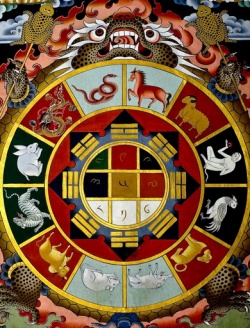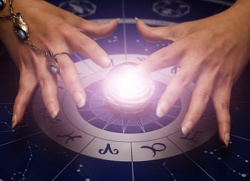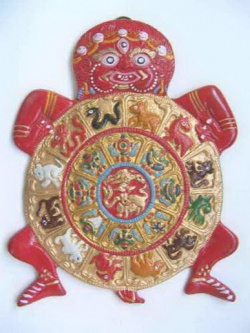Difference between revisions of "History of Tibetan Astrology"
(Created page with "thumb|250px| <poem> '''Tibetan Astrology''' has a long tradition and its oldest literature dates back to the 7th century. Before the time of Tibetan sc...") |
|||
| Line 1: | Line 1: | ||
[[File:839-hd.jpg|thumb|250px|]] | [[File:839-hd.jpg|thumb|250px|]] | ||
<poem> | <poem> | ||
| − | '''Tibetan Astrology''' has a long [[tradition]] and its oldest literature dates back to the 7th century. Before the time of Tibetan script [[astrological]] [[knowledge]] was passed down orally in songs and lyrics. | + | '''[[Tibetan Astrology]]''' has a long [[tradition]] and its oldest {{Wiki|literature}} dates back to the 7th century. Before the [[time]] of [[Tibetan]] script [[astrological]] [[knowledge]] was passed down orally in songs and lyrics. |
| − | The Tibetan system of Astro. Science is unique. Throughout time [[Tibetan astrology]] has developed with influences from neighboring countries such as [[China]], [[India]], Persia and Greece, mixed in synthesis with teachings from ancient [[Bön]] [[religion]] and [[Buddhist philosophy]]. Although [[Tibetan Astrology]] still has aspects similar to the [[Indian]] and Chinese systems, the way of using them is different and has been modified into an independent [[Tibetan]] system. | + | The [[Tibetan]] system of Astro. [[Science]] is unique. Throughout [[time]] [[Tibetan astrology]] has developed with influences from neighboring countries such as [[China]], [[India]], Persia and Greece, mixed in synthesis with teachings from ancient [[Bön]] [[religion]] and [[Buddhist philosophy]]. Although [[Tibetan Astrology]] still has aspects similar to the [[Indian]] and {{Wiki|Chinese}} systems, the way of using them is different and has been modified into an independent [[Tibetan]] system. |
Before 2nd century B.C. | Before 2nd century B.C. | ||
| − | In the ancient times, the shamanistic [[Bön]] [[religion]] was the main cult in [[Tibet]], and [[Elemental astrology]] was already practiced, but only a little is known of its original form. There was already knowledge of the five elements Wood, Fire, Earth, Iron and Water and the phases of [[Moon]] and [[Sun.]] The [[divination]] and prediction system was shamanistic with black and white magic, exorcism, sacrifice of animals and human blood letting. | + | In the ancient times, the shamanistic [[Bön]] [[religion]] was the main [[cult]] in [[Tibet]], and [[Elemental astrology]] was already practiced, but only a little is known of its original [[form]]. There was already [[knowledge]] of the [[five elements]] [[Wood]], [[Fire]], [[Earth]], Iron and [[Water]] and the phases of [[Moon]] and [[Sun.]] The [[divination]] and prediction system was shamanistic with black and white [[magic]], {{Wiki|exorcism}}, sacrifice of [[animals]] and [[human]] blood letting. |
2nd century B.C. - 4th century A.D. | 2nd century B.C. - 4th century A.D. | ||
| − | During the reign of [[Tibet]]'s first king, [[Nyatri Tsenpo]] (who ascended the throne in 127 B.C.) twelve major [[Bön]] [[doctrines]] were created with a detailed system of categories and sub-categories. [[Astrology]] and [[medicine]] were among those categories. | + | During the reign of [[Tibet]]'s first [[king]], [[Nyatri Tsenpo]] (who ascended the throne in 127 B.C.) twelve major [[Bön]] [[doctrines]] were created with a detailed system of categories and sub-categories. [[Astrology]] and [[medicine]] were among those categories. |
[[File:Astrologers.jpg|thumb|250px|]] | [[File:Astrologers.jpg|thumb|250px|]] | ||
| − | In time more [[knowledge]] of [[astrology]] developed, but it is difficult to place the timing of it. [[Bön]] [[astrologers]] connected the five elements together with [[Srog]] (lifeforce element), [[Lus]] (body - health element), [[Wangthang]] (empowering force) and [[Lungtha]] (success element). They also observe nine magic [[Mewa]] square numbers, and the system of twelve animal years started to form. From [[China]] comes the principle of eight [[Parkha]] [[trigrams]] (also known from [[I Ching]]). | + | In [[time]] more [[knowledge]] of [[astrology]] developed, but it is difficult to place the timing of it. [[Bön]] [[astrologers]] connected the [[five elements]] together with [[Srog]] (lifeforce [[element]]), [[Lus]] ([[body]] - health [[element]]), [[Wangthang]] ([[empowering]] force) and [[Lungtha]] (success [[element]]). They also observe nine [[magic]] [[Mewa]] square numbers, and the system of twelve [[animal]] years started to [[form]]. From [[China]] comes the principle of eight [[Parkha]] [[trigrams]] (also known from [[I Ching]]). |
4th century A.D | 4th century A.D | ||
| − | The first [[Buddhist]] teachings and scriptures came to [[Tibet]] and also bought advances in [[astrology]] and [[astronomy]]. | + | The first [[Buddhist]] teachings and [[scriptures]] came to [[Tibet]] and also bought advances in [[astrology]] and [[astronomy]]. |
6th century A.D. | 6th century A.D. | ||
| − | Tibetan King [[Namri Songtsen]] sent four [[scholars]] abroad to study [[astrology]]. They brought more [[astrology]] [[knowledge]] to [[Tibet]], where it was transmitted orally. | + | [[Tibetan]] [[King]] [[Namri Songtsen]] sent four [[scholars]] abroad to study [[astrology]]. They brought more [[astrology]] [[knowledge]] to [[Tibet]], where it was transmitted orally. |
7th century A.D. | 7th century A.D. | ||
| − | The 33th Tibetan King, [[Songtsen Gampo]] (617-650 A.D.) married his fifth wife, a Chinese princess, [[Kong Ju]]. In her dowries were some great statues of the [[Buddha]] (as were in the dowries of his Nepalese wife). But she was also an [[astrologer]] and brought with her various literature about classical Chinese [[Elemental astrology]]. The King built [[Buddhist]] [[temples]] and sent one of his ministers to [[India]] to create a [[Tibetan]] written language for the purpose of translating [[Buddhist]] scriptures into Tibetan. The project succeeded and from that time there is written information also about astrology. | + | The 33th [[Tibetan]] [[King]], [[Songtsen Gampo]] (617-650 A.D.) married his fifth wife, a {{Wiki|Chinese}} {{Wiki|princess}}, [[Kong Ju]]. In her dowries were some great [[statues]] of the [[Buddha]] (as were in the dowries of his Nepalese wife). But she was also an [[astrologer]] and brought with her various {{Wiki|literature}} about classical {{Wiki|Chinese}} [[Elemental astrology]]. The [[King]] built [[Buddhist]] [[temples]] and sent one of his ministers to [[India]] to create a [[Tibetan]] written [[language]] for the purpose of translating [[Buddhist]] [[scriptures]] into [[Tibetan]]. The project succeeded and from that [[time]] there is written [[information]] also about [[astrology]]. |
[[File:Astrology 9236.jpg|thumb|250px|]] | [[File:Astrology 9236.jpg|thumb|250px|]] | ||
8th century A.D. | 8th century A.D. | ||
| − | This century was a "Golden Age" in [[Tibetan medicine]], [[astrology]], and [[Dharma]] ([[Buddhist philosophy]]). There was great development in all fields of [[science]] and this period was an inspiration for [[Tibetan]] [[scholars]] for many centuries to come. King [[Trisong Detse]]n (718-785) invited Indian [[sage]] Guru [[PadmaSambhava]] to teach [[Dharma]]. He improved the [[Elemental Astrology]] by integrating with [[Buddhist philosophy]] and introduced the concept that elements in their pure form are the basis of all life in the [[universe]], and that the same elements in their impure form are poisonous to the [[body]]. | + | This century was a "Golden Age" in [[Tibetan medicine]], [[astrology]], and [[Dharma]] ([[Buddhist philosophy]]). There was great development in all fields of [[science]] and this period was an inspiration for [[Tibetan]] [[scholars]] for many centuries to come. [[King]] [[Trisong Detse]]n (718-785) invited [[Indian]] [[sage]] [[Guru]] [[PadmaSambhava]] to teach [[Dharma]]. He improved the [[Elemental Astrology]] by integrating with [[Buddhist philosophy]] and introduced the {{Wiki|concept}} that [[elements]] in their [[pure]] [[form]] are the [[basis of all]] [[life]] in the [[universe]], and that the same [[elements]] in their [[impure]] [[form]] are poisonous to the [[body]]. |
9th century A.D. | 9th century A.D. | ||
| − | Tibet [[suffers]] under weak leadership and cultural decline, which also has an unfortunate effect on [[Tibetan astrology]]. | + | [[Tibet]] [[suffers]] under weak leadership and cultural decline, which also has an unfortunate effect on [[Tibetan astrology]]. |
10th century A.D. | 10th century A.D. | ||
| − | After a change of leadership in Tibet, the new king sent scholars to India to bring back some of the teachings, which was lost. This period is called the "Later translation" in Tibetan history records and in another text important astrology scriptures were translated. [[Elemental astrology]] came under more Chinese influence from East Turkistan and started to use the 60-year element-animal cycle. | + | After a [[change]] of leadership in [[Tibet]], the new [[king]] sent [[scholars]] to [[India]] to bring back some of the teachings, which was lost. This period is called the "Later translation" in [[Tibetan history]] records and in another text important [[astrology]] [[scriptures]] were translated. [[Elemental astrology]] came under more {{Wiki|Chinese}} [[influence]] from East Turkistan and started to use the 60-year element-animal cycle. |
11th century A.D. | 11th century A.D. | ||
| − | The Sri [[Kalachakra Tantra]] was translated from [[Sanskrit]] into [[Tibetan]] in Fire-rabbit year 1027 A.D. This text forms the basis of modern Tibetan [[astronomy]] and its principles are the basis for Tibetan calendar making with day-to-day positions of the stars, the planets and signs of the zodiac. | + | The Sri [[Kalachakra Tantra]] was translated from [[Sanskrit]] into [[Tibetan]] in Fire-rabbit year 1027 A.D. This text [[forms]] the basis of modern [[Tibetan]] [[astronomy]] and its principles are the basis for [[Tibetan]] calendar making with day-to-day positions of the stars, the [[planets]] and signs of the zodiac. |
12th century A.D. | 12th century A.D. | ||
| Line 38: | Line 38: | ||
17th century A.D. | 17th century A.D. | ||
| − | Tibetan astronomy and [[astrology]] reached a new peak when a collection of [[astrological]] scriptures was written by [[Desi Sangye Gyatso]], who was a regent for H.H. the [[fifth Dalai]] Lama, Ngawang Lobsang Gyatso. Even after almost four centuries this scripture is still used by Tibetan astrologers. | + | [[Tibetan]] {{Wiki|astronomy}} and [[astrology]] reached a new peak when a collection of [[astrological]] [[scriptures]] was written by [[Desi Sangye Gyatso]], who was a regent for H.H. the [[fifth Dalai]] [[Lama]], [[Ngawang Lobsang Gyatso]]. Even after almost four centuries this [[scripture]] is still used by [[Tibetan]] [[astrologers]]. |
20th century A.D. | 20th century A.D. | ||
| − | The [[13th Dalai Lama]] established the [[medicine]] and [[astrology]] institute [[Men-Tsee-Khang]] in 1916 in [[Lhasa]]. After fleeing from the Chinese the exiled [[14th Dalai Lama]] re-established [[Men-Tsee-Khang]] in 1961 in [[Dharamsala]] in the North Indian Himalayas. | + | The [[13th Dalai Lama]] established the [[medicine]] and [[astrology]] institute [[Men-Tsee-Khang]] in 1916 in [[Lhasa]]. After fleeing from the {{Wiki|Chinese}} the exiled [[14th Dalai Lama]] re-established [[Men-Tsee-Khang]] in 1961 in [[Dharamsala]] in the North [[Indian]] [[Himalayas]]. |
</poem> | </poem> | ||
{{R}} | {{R}} | ||
[http://www.tactus.dk/tacom/tibetanastrology3.htm www.tactus.dk] | [http://www.tactus.dk/tacom/tibetanastrology3.htm www.tactus.dk] | ||
[[Category:Tibetan Astrology]] | [[Category:Tibetan Astrology]] | ||
Revision as of 09:36, 5 September 2013
Tibetan Astrology has a long tradition and its oldest literature dates back to the 7th century. Before the time of Tibetan script astrological knowledge was passed down orally in songs and lyrics.
The Tibetan system of Astro. Science is unique. Throughout time Tibetan astrology has developed with influences from neighboring countries such as China, India, Persia and Greece, mixed in synthesis with teachings from ancient Bön religion and Buddhist philosophy. Although Tibetan Astrology still has aspects similar to the Indian and Chinese systems, the way of using them is different and has been modified into an independent Tibetan system.
Before 2nd century B.C.
In the ancient times, the shamanistic Bön religion was the main cult in Tibet, and Elemental astrology was already practiced, but only a little is known of its original form. There was already knowledge of the five elements Wood, Fire, Earth, Iron and Water and the phases of Moon and Sun. The divination and prediction system was shamanistic with black and white magic, exorcism, sacrifice of animals and human blood letting.
2nd century B.C. - 4th century A.D.
During the reign of Tibet's first king, Nyatri Tsenpo (who ascended the throne in 127 B.C.) twelve major Bön doctrines were created with a detailed system of categories and sub-categories. Astrology and medicine were among those categories.
In time more knowledge of astrology developed, but it is difficult to place the timing of it. Bön astrologers connected the five elements together with Srog (lifeforce element), Lus (body - health element), Wangthang (empowering force) and Lungtha (success element). They also observe nine magic Mewa square numbers, and the system of twelve animal years started to form. From China comes the principle of eight Parkha trigrams (also known from I Ching).
4th century A.D
The first Buddhist teachings and scriptures came to Tibet and also bought advances in astrology and astronomy.
6th century A.D.
Tibetan King Namri Songtsen sent four scholars abroad to study astrology. They brought more astrology knowledge to Tibet, where it was transmitted orally.
7th century A.D.
The 33th Tibetan King, Songtsen Gampo (617-650 A.D.) married his fifth wife, a Chinese princess, Kong Ju. In her dowries were some great statues of the Buddha (as were in the dowries of his Nepalese wife). But she was also an astrologer and brought with her various literature about classical Chinese Elemental astrology. The King built Buddhist temples and sent one of his ministers to India to create a Tibetan written language for the purpose of translating Buddhist scriptures into Tibetan. The project succeeded and from that time there is written information also about astrology.
8th century A.D.
This century was a "Golden Age" in Tibetan medicine, astrology, and Dharma (Buddhist philosophy). There was great development in all fields of science and this period was an inspiration for Tibetan scholars for many centuries to come. King Trisong Detsen (718-785) invited Indian sage Guru PadmaSambhava to teach Dharma. He improved the Elemental Astrology by integrating with Buddhist philosophy and introduced the concept that elements in their pure form are the basis of all life in the universe, and that the same elements in their impure form are poisonous to the body.
9th century A.D.
Tibet suffers under weak leadership and cultural decline, which also has an unfortunate effect on Tibetan astrology.
10th century A.D.
After a change of leadership in Tibet, the new king sent scholars to India to bring back some of the teachings, which was lost. This period is called the "Later translation" in Tibetan history records and in another text important astrology scriptures were translated. Elemental astrology came under more Chinese influence from East Turkistan and started to use the 60-year element-animal cycle.
11th century A.D.
The Sri Kalachakra Tantra was translated from Sanskrit into Tibetan in Fire-rabbit year 1027 A.D. This text forms the basis of modern Tibetan astronomy and its principles are the basis for Tibetan calendar making with day-to-day positions of the stars, the planets and signs of the zodiac.
12th century A.D.
Yangchar (Shiva Sarodhaya Tantra), which means Arising Vowels, was translated from the original Sanskrit text to Tibetan.
17th century A.D.
Tibetan astronomy and astrology reached a new peak when a collection of astrological scriptures was written by Desi Sangye Gyatso, who was a regent for H.H. the fifth Dalai Lama, Ngawang Lobsang Gyatso. Even after almost four centuries this scripture is still used by Tibetan astrologers.
20th century A.D.
The 13th Dalai Lama established the medicine and astrology institute Men-Tsee-Khang in 1916 in Lhasa. After fleeing from the Chinese the exiled 14th Dalai Lama re-established Men-Tsee-Khang in 1961 in Dharamsala in the North Indian Himalayas.


